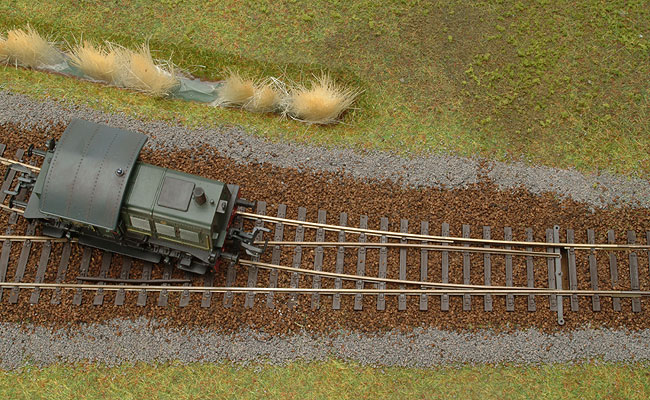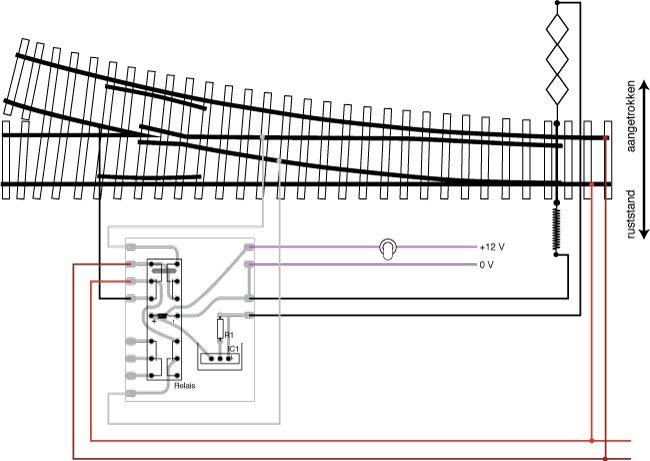Actuators with memory wire

Actuators for points can be bought in all sorts and sizes. There are many solenoid and motor based solutions. For De Lage Zij I choose to use memory actuators. Unfortunately memory wire actuators cannot be bought off the shelf. So I designed a simple but reliable solution myself.
Memory wire has several advantages over solenoids and motors. It doesn’t make any sound. A memory wire actuator has hardly any moving parts, which makes it very reliable. The movement is very slow and self-stopping. Above all, memory wire is quite cheap.

The basic principle behind the actuator is quite simple. When memory wire is heated, it will shrink by about 3.5%. When it cools down, the movement is reverted and the wire stretches out again. A 11 cm piece of wire will therefore produce a linear movement of about 3.5 mm. That is well enough to move a set of H0 points. The movement takes almost 3 seconds.

The actuator consists of a little nail, a spring, a brass crimp, a piece of thin brass tubing (4 cm long), a paperclip and a piece of memory wire. The spring holds the point rails in the first position and keeps the memory stretched. The other side of the memory wire is wound around the brass tube. The part of the tube that sticks out under the layout is bent in a 90 degree angle to form a lever. By turning the lever you can adjust the tension in the memory wire. When you send a current trough the wire, it heats up and contracts. The point rails are now in the second position. After switching the current of, the wire cools down and the spring pulls the rails back into the first position.

The first step is cutting a shallow slot into the baseboard under the point. A household router is a perfect tool for the job. After painting the baseboard, the actuator is assembled on the bottom of the cut. The paperclip is bend to form a double hook, which will connect the spring and the memory wire. The long leg of the hook will slide into the throw bar. The entire actuator will be hidden under the landscape of you layout.

Memory wire needs a current of 200 mA to contract completely. You cannot connect it directly to model railroad transformer, because the high voltage would generate a too big current. The problem can easily be solved with the aid of a few electronic components. The LM 317 voltage regulator can be used to generate a constant current. A little 0.5 W resistor is enough to limit the power output to 200 mA. It does not matter how long the memory wire is. The LM 317 needs to be supplied with12 V DC and has be equipped with a heat sink.

The circuit is enough to make the point move, but with a 2-rail layout the frog needs also be polarised correctly. You can easily achieve that by putting a simple relay parallel to the LM 317. The relay switches the frog between the ground and plus terminals of your (digital) power supply.
| Parts | Symbole | Type | Conrad part number |
| IC1 | LM317T (TO220) | 176001 |
| R1 | 5.6 Ohm, 1/2 W | 417955 |
| Relais (relay) | RA4-12W-K | 502910 |
| C1 | 220 µF 25V | 472522 |
| C2 | 0.1 µF 25V | 453099 |
| Rectifier | 501883 | |
| Heat sink for LM317T | 188271 | |
First I decided to connect both point rails of the Tillig points directly to the power supply. However some
locomotives caused a short circuit when their wheels touched the opposing point/wing
rail near the frog. That’s why I have isolated the frog from
the point and wing rails. An extra set of switches in the relay
makes sure only the used point and wing rails are connected to
the power supply.

The entire circuit will easily fit on a small piece of circuit board. You can etch your own or use standard veroboard. The second option is faster, easier and cheaper. I first cut the board to size and then put a sticker on the top. The sticker outlines the correct placement of all parts and makes it easy to build the circuit without counting holes all the time.
The memory wire, the springs and the crimps can be bought from ProRail International. You can order the electronics from Conrad. I have included the part numbers in the table.
2004